Learn about Tibetan culture, support a school and promote eco-friendly practices
Dharamsala, Himachal Pradesh
Volunteer project: Valleys of the Himalayas - This small paradise on earth is home to His Holiness the 14th Dalai Lama and to a significant Tibetan settlement in India. Dharamshala is set in the backdrop of the snow-clad peaks of Dhaulathar Mountains. It is the capital of the Tibetan Government-in-exile and the residence of the Dalai Lama.
The project aims to support a local school with construction, renovation and educational activities, and to provide a cleaner environment for the community which is being affected by tourist influx and lack of waste management and watershed management systems. The project also wants to create awareness on the Tibetan migrants and their culture.
We have been conducting international volunteer projects in McLeod Ganj, Dharamsala for the last 12 years with the purpose of bringing a sustainable model for development of the region in partnership with school management committees, the Tibetan Welfare Office and the local municipality.
The volunteers will help build a safety wall for a school where the land is sloping, so the children can play without fear of danger, and will work on the renovation of classroom walls, to give children a colorful learning atmosphere. You can also bring basic education to the local school children with creative methods. There is a huge amount of waste generation in the community, which is harmful to the environment. The group will raise awareness for the protection of the environment and solid waste management. You will visit various Tibetan cultural Institutes and Tibetan Children’s Village to learn about the Tibetan migrants.
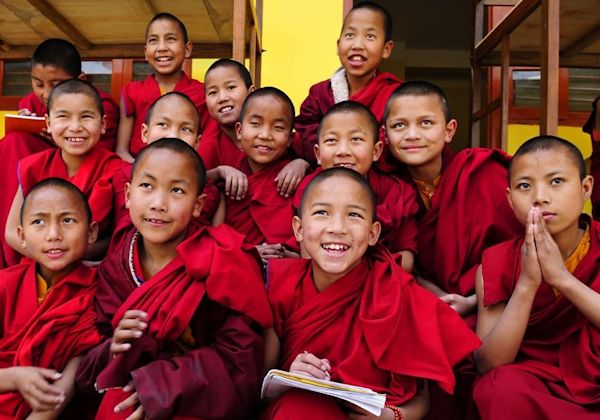
Volunteer activities:
- Share your ideas and promote eco-friendly practices
- Help to renovate school buildings and paint walls
- Help to build a retaining wall and a playground extension
- Unleash your creativity with educational drawings (murals)
- Teach basic English to children
- Help clean up Bhagsu waterfalls and river
- Create awareness in the community and among tourists on responsible tourism, health and hygiene
- Protect the landscape, plant trees
Leisure activities: During the project, the volunteers will get the opportunity to learn about the Tibetan culture and the different issues related to the exile of its people and their re-settlement in India. There will be cultural activities, visits to important cultural sites and various Tibetan institutes, meetings with Tibetan monks and the local community.
During the first week of the project, the volunteers will participate in Yoga classes with a professional instructor.
After the end of the second week, the volunteers can take part in an optional 2 to 4-day trekking activity around the mountains of Dharamsala and Triund. The cost of the trekking is from 3,000 to 7,000 Indian Rupees per person.
Tibet has maintained a unique culture, religion and language for centuries. After the Chinese invasion in 1950, the Dalai Lama, Tibet's political and religious leader sought and was given asylum in India, along with thousands of Tibetan refugees. Today, there is a thriving settlement in Dharamshala, which is called Tibet-in-exile. To learn about Tibetan culture and religion, there are many places of interest at Dharamshala. Tsuglagkhang, Mcleodganj the residence of the Dalai Lama is a must-visit, as are the Tibet Museum, Dalai Lama temple, Tibetan Parliament House, Library of Tibetan Works and Archives, War Memorial and Kangra Art Museum. The Tibetan Children's Village caters to children who are in the greatest need among the refugees. At Gyuto and Namgyal Monasteries, you can interact with the Tibetan monks and get valuable insights into the peace-loving Buddhist philosophy. If you are in the right place at the right time, you could even be fortunate enough to meet His Holiness, the 14th Dalai Lama himself. Palampur, the Tea Capital of North India is famous for its beautiful tea gardens, which are a natural scenic sight. Tea lovers can pick up some handcrafted, fresh mountain teas here.
Language: English
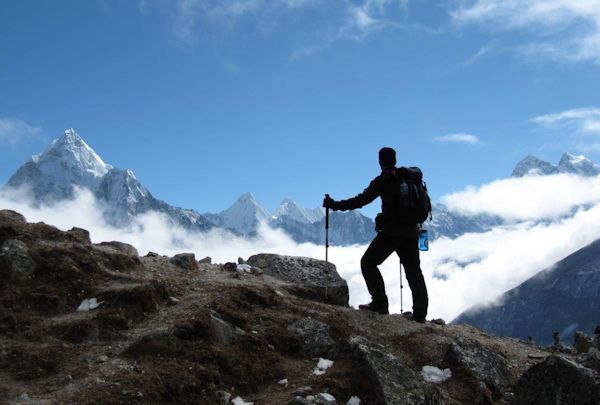
Accommodation: In a guest house or hostel, in shared rooms with bunk beds.
Location: Dharamshala holds a very significant position as the second (winter) capital of Himachal Pradesh. It is also the abode of the Tibetan spiritual leader, the 14th Dalai Lama, and the capital of the Tibetan government-in-exile, with a considerable Tibetan settlement. It is one of the most beautiful, scenic places in the world.
McLeod Ganj is a suburb of Dharamshala in Kangra district. Dharamshala is located in the state of Himachal Pradesh, North India, 500 kilometers from Delhi. Dharamshala is accessible by bus on a daily basis from New Delhi and other smaller cities of North India. The nearest railway stations are Pathankot and Kangra Mandir. Delhi is the nearest international airport.
Age range: 18 and over
Extra fee: 18,500 Indian Rupees (about $260 US)
The extra fee is intended to support the local host of the project who does not have sufficient funds. It is due upon arrival.
Sustainable agriculture and school support in Kundapur
Kundapur, Karnataka
Volunteer project: Kundapur is a town situated near the beach on the west coast of Karnataka state, and is very close to the Western Ghats (a mountain ridge). The Western Ghats is India's prime zone for bio-diversity, known for the number of animal and plant species in this region. We have been involved in developing projects in the region for many years and have formed a very strong network of local partners and local volunteers.
The focus of the project is providing field-based knowledge on sustainable agriculture and its impact, and introducing creative learning methods in schools. The volunteers will work with farmers, women groups and schools in different villages in the region.
The volunteers will be engaged in the following activities:
• Teaching in schools and renovation work
• Exposure visits to model farms
• Working on a sustainable agriculture farm
• Conducting a drawing competition in a school
• Visiting Tibetan golden temple
• One-day trekking
• Visiting the beach and a lighthouse
• Indian family visit, learning about henna culture
• Learning the basics of Yoga and practicing Yoga in the 1st week
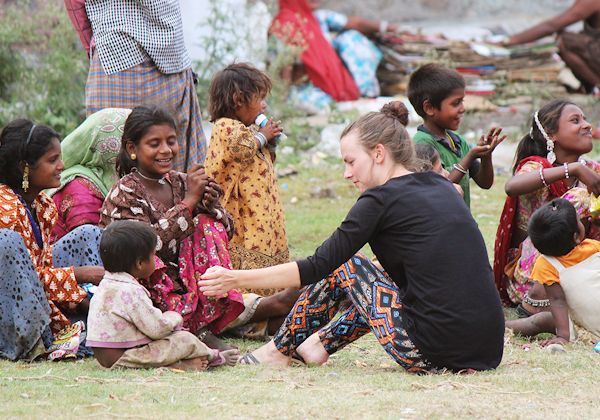
Leisure activities: Visits to cultural and religious sites, family visits as part of the inter-cultural learning and participation in cultural programs with the local community.
Language: English
Accommodation: In a guest house or youth hostel. The accommodation is simple but comfortable.
Location: Kundapur is a coastal town in Udupi district, Karnataka state in South India. Kundapur is located at the Arabian sea coast, 440 km north west of Bangalore, 91 km north of Mangalore and 35 km from Udupi. The nearest international airports are Bangalore and Mangalore. Kundapur can also be reached from Mumbai, Goa, Bangalore, Mangalore and Kerala by train/bus.
Age range: 18 and over
Extra fee: 17,000 Indian Rupees (about $240 US)
The extra fee is intended to support the local host of the project who does not have sufficient funds. It is due upon arrival.
Teaching, raising environmental awareness and renovating schools in Jaipur
Jaipur, Rajasthan
Volunteer project: Jaipur, the fascinating capital of the desert state of Rajasthan, is one of the best planned cities of its time and is part of the ‘Golden Triangle’ along with Delhi and Agra. The graceful architecture of the city all in the colour pink has earned Jaipur the title of the ‘Pink City’. It is predominantly known for its musicians, artisans and craftsmen. Today, tourists flock to the city attracted by its fine jewelry, varied textiles and sumptuous cuisine.
The aim of the volunteer project is to create awareness on environmental issues affecting this city, to create better learning facilities for school kids, and to provide community service to slum dwellers and poor children.
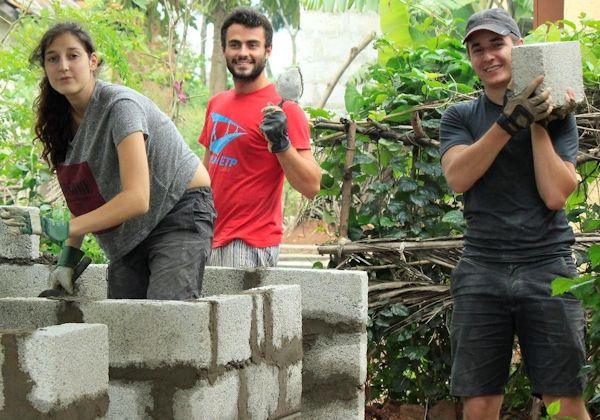
The project involves teaching basic English to children from poor and marginalized communities in non-formal schools through creative teaching methods like art, music, games, etc. The volunteers will undertake simple renovation work to improve school infrastructure including renovation of a school kitchen, wall painting and making a kitchen garden. The group will help educate children from the slums and the local community on health, hygiene, and waste management. Volunteers will also plant trees along with community members.
Leisure activities: A world heritage site, Jaipur is chock full of visual treats and Amer Fort or Palace, the erstwhile official residence of the Rajput Maharajas and their families, is only one of them. It was built of red sandstone and marble over a period of 2 centuries. A must-see here is Sheesh Mahal (Hall of Mirrors), built with tiny pieces of mirrors, to create the illusion of stars for royal ladies who were not permitted to sleep in the open.
Jantar Mantar is a world heritage site in itself, featuring the world’s largest stone sundial and 19 other architectural astronomical instruments built by Sawai Jai Singh II, the founder of Jaipur. City Palace, the home of the Jaipur royal family houses a museum where priceless artifacts and royal cenotaphs are on display. Hawa Mahal (Palace of Winds) is the tallest building in the world without a foundation. Its intricate, honeycomb architecture with 953 windows allows the breeze to flow through it and keep it cool. Jaipur is home to the most fabulous collection of jewellery. Haathi Gaon (Elephant Village) is where over 100 elephants are housed along with 7th generation keepers. Here, you can feed, bathe, ride the elephants and take as many photographs as you like.
Language: English
Accommodation: In a guest house or hostel, in shared rooms.
Location: Jaipur is located 268 km south of Delhi, the national capital, and is well connected to other parts of the country through air, rail and road. Jaipur International Airport is located 13 km from Jaipur. Jaipur is well connected by bus and trains to most of the major cities in India. Regular buses are available from Delhi and other cities in North India.
Age range: 18 and over
Extra fee: 17,500 Indian Rupees (about $245 US)
The extra fee is intended to support the local host of the project who does not have sufficient funds. It is due upon arrival.
Education and awareness projects in Rajasthan
Jodhpur, Rajasthan
Volunteer project: Jodhpur, city of perennial sunshine is known by many names - ‘Sun City’, ‘Blue City, ‘Gateway to Thar’. Many of the houses in the old city are painted blue to retain coolness, and from an aerial view, you can see how the city got its most popular name. Palaces, forts, temples and a bustling market rub shoulders with prestigious educational and research institutes, making it an interesting amalgam of both ancient and modern worlds. Once the capital of the kingdom of Marwar, it is one of the most enchanting cities in India.
The focus of the project is to create awareness on environmental issues to school children and the community, to introduce the school children to creative learning methods, bring better facilities and a cheerful atmosphere to the schoolroom. Visits to a traditional Marwari community steeped in ancient traditions and local Indian families for intercultural exchange are some of the highlights of this volunteer project.
Volunteer activities:
• Mold young minds, teach basic English in schools with non-formal and creative learning methods like art, music, games
• Help renovate a school to provide better facilities for school children
• Unleash your creativity, paint educational murals on school walls
• An amazing cultural visit to Bishnoi village, interact with Rajasthan’s Marwari community, learn about their unique life principles and traditions, handed down from the 15th century
• Visit a local Indian family and exchange notes on your experiences
• Conduct upcycling activities, teach school children about creative recycling
• Educate school children to be eco-conscious, create awareness on waste management
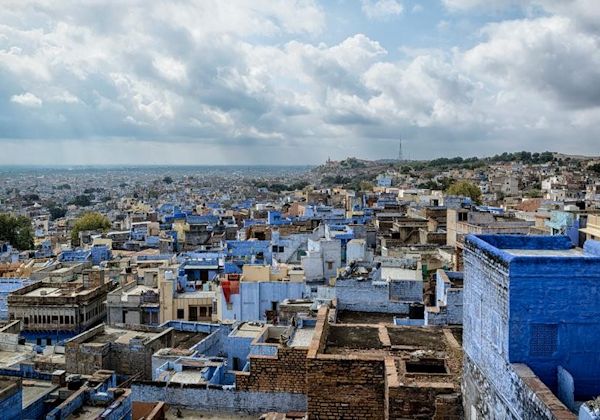
Leisure activities: Mehrangarh Fort, one of the largest forts in India has 7 gates, each with a significant name of its own. Several palaces, courtyards, and exhibits of the Rathore clan including arms, miniatures, costumes, including a large selection of howdahs and palanquins are found at the end of a long, winding road from the city of Jodhpur. Legends and curses swirl around this mysterious stronghold, which also preserves old cannons and provides a breathtaking view of the city.
The 16th century Achal Nath Shivalaya temple, dedicated to Shiva, is a tribute to the architectural grandeur of the Hindu religion. The temple of Vishnu in the ancient city of Osian, noted for its elaborate architecture was constructed in the 9th century and is worth a visit. A desert ride on the back of a swaying camel is an exciting add-on. The Ghanta Ghar or Clock Tower is a popular landmark of the city. While you are there, you can stroll through the narrow alleys of Sardar Market, where you can shop for spices, Indian sweets, textiles, silver and handicrafts.
Language: English
Accommodation: In a guesthouse or hostel, in shared rooms.
Location: Jodhpur is located in the state of Rajasthan, 560 km south west of Delhi, and is accessible by domestic airlines. Jodhpur is connected by air to major airports in Delhi, Mumbai, Jaipur, Udaipur. The airport is about 5 km from the city center. Trains and buses operate on a daily basis from New Delhi and Mumbai.
Age range: 18 and over
Extra fee: 17,500 Indian Rupees (about $245 US)
The extra fee is intended to support the local host of the project who does not have sufficient funds. It is due upon arrival.
Raise awareness and help preserve the glorious cultural heritage of Jaipur
Jaipur, Rajasthan
Volunteer project: In 1876, when Queen Victoria and the Prince of Wales visited Jaipur, Maharaja Ram Singh painted the entire city pink to welcome his royal guests. Pink is the colour of hospitality and for centuries, the walled city of Jaipur has been host to thousands of tourists from all over the world. It was built according to a grid plan, with Vedic architectural interpretation. Its urban planning is a blend of ancient Hindu, modern Mughal and Western styles. Jaipur has recently been declared the 38th world heritage site of India. Its tempting cuisine, beautiful carpets, jewellery, textiles, folk dances, and intricate architecture are what make it a must-visit city.
The aim of the volunteer project is to create awareness on world heritage sites and monuments in the community. We work closely with UNESCO, Archeological Survey of India and the local authorities to protect and conserve India’s glorious cultural heritage. We also aim to supplement the education of local school children with non-formal teaching methods, and painting of educational murals.
Volunteer activities:
• Get relevant first-hand information on Indian architectural history and culture, have meaningful interactions with
Archaeological Society of India officials
• Pitch in to clean up around heritage sites and preserve their beauty
• Help create awareness on heritage and the importance of monuments in the local community
• Teach basic English in schools with non-formal and creative learning methods like art, music, games, etc.
• Unleash your creativity with mural painting at a school and public areas to create awareness on India’s heritage
• Conduct a drawing competition for school children on the awareness of their country’s heritage
• Help renovate a school, provide better facilities for school children
• Exchange cultural experiences with the community, interact closely with a Rajasthani Indian family
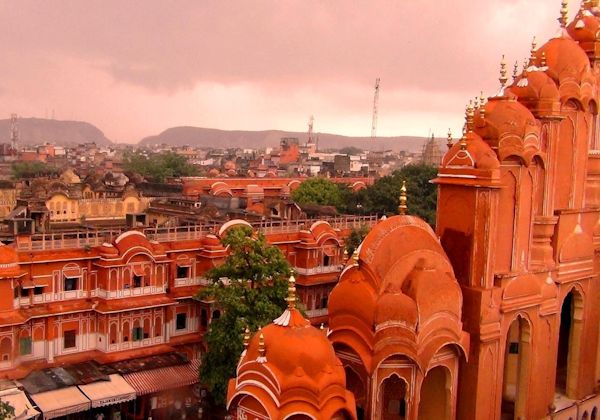
Leisure activities: A world heritage site, Jaipur is chock full of visual treats and Amer Fort or Palace, the erstwhile official residence of the Rajput Maharajas and their families, is only one of them. It was built of red sandstone and marble over a period of 2 centuries. A must-see here is Sheesh Mahal (Hall of Mirrors), built with tiny pieces of mirrors, to create the illusion of stars for royal ladies who were not permitted to sleep in the open.
Jantar Mantar is a world heritage site in itself, featuring the world’s largest stone sundial and 19 other architectural astronomical instruments built by Sawai Jai Singh II, the founder of Jaipur. City Palace, the home of the Jaipur royal family houses a museum where priceless artifacts and royal cenotaphs are on display. Hawa Mahal (Palace of Winds) is the tallest building in the world without a foundation. Its intricate, honeycomb architecture with 953 windows allows the breeze to flow through it and keep it cool. Jaipur is home to the most fabulous collection of jewellery. Haathi Gaon (Elephant Village) is where over 100 elephants are housed along with 7th generation keepers. Here, you can feed, bathe, ride the elephants and take as many photographs as you like.
Language: English
Accommodation: In a guest house or hostel, in shared rooms.
Location: Jaipur is located 268 km south of Delhi, the national capital, and is well connected to other parts of the country through air, rail and road. Jaipur International Airport is located 13 km from Jaipur. Jaipur is well connected by bus and trains to most of the major cities in India. Regular buses are available from Delhi and other cities in North India.
Age range: 18 and over
Extra fee: 17,500 Indian Rupees (about $245 US)
The extra fee is intended to support the local host of the project who does not have sufficient funds. It is due upon arrival.
Protection of the World Heritage Site at Hampi
Hampi, Karnataka
Volunteer project: Once upon a time, Hampi-Vijayanagara, located in central Karnataka, was the world's second-largest medieval city after Beijing, and India's richest, attracting traders from as far as Persia and Portugal. Hampi fell into ruins when the Vijayanagara Empire was defeated and pillaged by a coalition of Deccan Muslim sultanates in 1565. It is now a UNESCO world heritage site, visited by thousands of travellers due to its breathtaking temples, intricate sculptures and monuments, which give an insight into the splendour and architectural skills of the ancient Hindu kingdom.
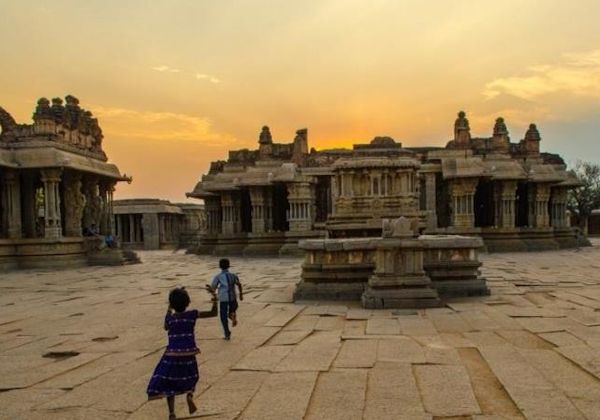
Hampi attracts thousands of tourists and pilgrims every year. Vast stretches of boulder-strewn hills make the backdrop of Hampi unique. Dotted around the hills and valleys are over 500 monuments. Among them are beautiful temples, basement of palaces, remains of aquatic structures, ancient market streets, royal pavilions, bastions, royal platforms, treasury buildings, etc. Hampi is a backpacker’s paradise - every monument hides more than it reveals.
The project in Hampi will focus on the protection of the cultural heritage and the sites of historical importance and on creating awareness among the locals, school children, tour guides and tourists, to instill a sense of responsibility towards the protection of these priceless monuments. We've been running the projects in Hampi for the past 10 years with the cooperation of UNESCO World Heritage Centre, the Archaeological Survey of India and local associations. Here, you will help to convert dry areas into beautiful, restful spots by planting trees and flowering plants. Street plays to create awareness, creativity, physical work and archaeological delights are all hallmarks of this unique project.
Join us and take part in the following activities:
• Scale up your knowledge on historical monuments of India, attend an introductory session with archaeology and heritage conservation officials, interact with officials from the Indian National Trust for Art and Cultural Heritage
• Clean up the scrub around monuments dating back to 1 CE, to preserve and maintain their beauty and cultural heritage
• Help to combat global warming and also create pleasant, green spots by planting trees and flowering shrubs
• Awaken your thespian skills with a Street Play, to create awareness of heritage conservation to the locals
• Conduct a drawing competition for school children, help showcase their talent by setting up an open gallery
• Instill national pride in school children, make them aware of their rich cultural and historical heritage
• Install garbage bins in the community, help manage waste
• Use your creativity to educate the public on heritage conservation, paint murals in public areas
Leisure activities: Some of the fun things to do at Hampi are taking a coracle ride in the nearby Tungabhadra river. These round cane boats have been a mode of transport here since the 15th century. You can also rent a bicycle and take the trail down to any of the interesting ruins, go bouldering or trekking.
Some must-visits are Vijaya Vittala, the extraordinary architectural marvel with 56 musical pillars, which create melodic sounds when tapped delicately, the stunning Virupaksha and Krishna temples, the Royal Enclosure with the Queen’s bath and Lotus Mahal (palace).
Anegundi, or Kishkindha, the capital of the Vijayanagar empire is a fine repository of Neolithic history and prehistoric rock art, represented by Mourya Mane, a several-thousand-year-old Stone Age colony. You can visit the birthplace of Hanuman, the monkey god, or peek at the ancient elephant stable, where the city’s elephants were fed, bathed and trained for battle and other activities.
Language: English
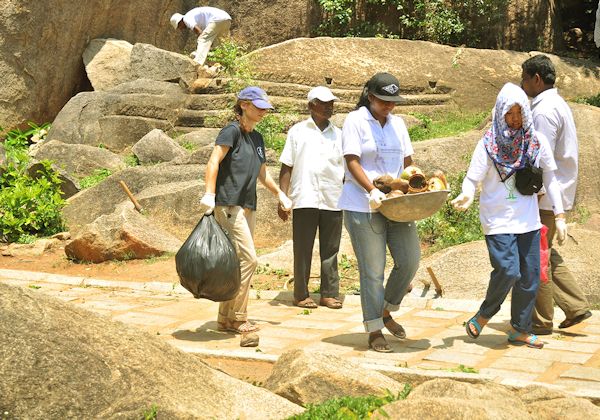
Accommodation: In a guest house or hostel, in shared rooms.
Location: Hampi is located in the state of Karnataka, 350 km north of Bangalore and 13 km from Hospet. Hampi is accessible by bus from Bangalore and Goa. The nearest railway station is in Hospet. The nearest international airports are Bangalore, Mumbai and Panjim.
Age range: 18 and over
Extra fee: 17,500 Indian Rupees (about $245 US)
The extra fee is intended to support the local host of the project who does not have sufficient funds. It is due upon arrival.
Teaching English, improving school facilities and raising environmental awareness in Mysore
Mysore, Karnataka
Volunteer project: From time immemorial, the fragrance of sandalwood has delighted the connoisseurs of perfume. Mysore, India’s ‘Sandalwood City’ also known as the ‘City of Palaces’ is the cultural capital of the state of Karnataka. For nearly 6 centuries, the kingdom of Mysore was ruled by the Wodeyar dynasty, who were patrons of art and culture. An enlightened dynasty, the Wodeyars contributed significantly to the cultural and economic growth of the city and the state. In Mysore city, an ‘old-world’ ambience prevails. One can almost see the ghosts of years gone by, hear a faint battle-cry, the clash of weapons, or the boom of a cannon.
Mysore being the cultural capital of Karnataka, is a great place to learn about the culture and history of the state. However, the main objective of the volunteer project is to make a difference to the existing educational system by introducing creative learning methods to the school children, improving the facilities of the school, and creating awareness on environmental issues within the community. Gaining first-hand agricultural knowledge from local farmers, and intercultural exchange are some of the highlights of this project.
Volunteer activities:
• Mold young minds, teach basic English in schools with non-formal and creative learning methods like art, music, games
• Help renovate a school to provide better facilities for school children
• Unleash your creativity, paint educational murals on school walls
• Conduct upcycling activities, teach school children about creative recycling
• Educate school children to be eco-conscious, create awareness on waste management
• Help to combat global warming and also create pleasant, green spots by planting trees and flowering shrubs in the community
• Visit a local Indian family and exchange notes on your experiences
• Be part of an exposure visit to an organic farm and acquire hands-on experience in farming activities
• Talk to local farmers and learn about their methods of natural resource management
Leisure activities: Mysore palace is the official residence of the Wodeyar family and was the administrative seat of the kingdom of Mysore for centuries. Built mainly in the Indo-Saracenic style of architecture, it houses a treasure trove of beautiful paintings and objets d’art, collected over the years by the royal family. Antique lovers will find it hard to budge from here, with such a visual feast at hand.
At Mysore, Dasara is celebrated ceremoniously in October, with the warriors as well as the state fighting for the good, displaying the state sword and weapons. Richly caparisoned elephants and horses along with the goddess Chamundeshwari in her warrior form, dancers, jugglers, musical bands and elaborate floats parade before the royal family and bedazzled tourists from the world over.
The Brindavan Gardens took 5 years to complete and lies adjoining the Krishnarajasagara Dam, which is built across the river Kaveri. It is spread across 60 acres, with an adjoining fruit orchard of 75 acres and has 3 terraces, with a topiary, gazebos and pergolas, ficus trees, foliage and flowering plants. However, the main attraction is the musical fountain which plays music synchronised to bursts of water and scintillating lights.
In Hindu folklore, Mysore was plagued by the demon-king Mahishasura, a buffalo-headed monster. An ancient stone staircase of 1008 steps leads to the temple of the goddess Chamundeshwari, who fought and killed the demon, thereby liberating the city from his tyranny. Halfway to the shrine is a huge statue of a Nandi bull, carved out of a single piece of black granite. Hiking up this historic hill is a pleasurable experience, from the top of which lies a breathtaking view of the city of Mysore.
In an interim period, Mysore was ruled by Hyder Ali and his son, Tipu Sultan known as the ‘Tiger of Mysore’, who fought valiantly against the British to keep the Deccan independent. A fact not known to many is that Tipu was also a pioneer of rocket technology in India. Srirangapatna, his capital, is where relics of Tipu’s reign can be viewed. It is also a place of pilgrimage for the Vaishnavite sect of Hinduism whose Ranganathaswamy temple draws thousands of pilgrims every year.
The Sand Sculpture museum holds more than 150 sand sculptures showcasing 16 different themes, made out of 115 lorry loads of sand, and is the only one of its kind in India. The Mysore Zoo is more than 100 years old and has been open to the public since 1902. Exotic animals, birds and reptiles are housed here and it also includes a bird sanctuary at Karanji Lake.
Language: English
Accommodation: In a guesthouse or hostel, in shared rooms.
Location: Mysore is located in the state of Karnataka in South India, about 185 km north of Bangalore. The nearest international airport is Bangalore. Trains and buses operate on an everyday basis from almost all major towns/cities in South India.
Age range: 18 and over
Extra fee: 17,500 Indian Rupees (about $245 US)
The extra fee is intended to support the local host of the project who does not have sufficient funds. It is due upon arrival.
Sustainable agriculture program
Kundapur, Karnataka 1 - 4 weeks
Volunteer project: Kundapura is at the centre of Karnataka’s coastal belt and has many beautiful beaches. ‘Kunda’ means pillar, referring to the traditional method of constructing houses and ‘pura’ means town. Its traditional cuisine is well known all over India, coconut being an important ingredient of most of its culinary offerings. Kundapura has a laidback atmosphere and has many quaint customs and traditions, which you would find interesting and entertaining.
The Sustainable agriculture program takes place in Kundapur, in the lush green, rural area of coastal Karnataka, which is home to breathtaking fauna and flora. The project base is surrounded by coconut and mango trees, creating an atmosphere of peace and tranquility. The program was initiated with a vision to evolve a model of sustainable agriculture and livelihood by involving and integrating different farming systems for efficient use of conservation and management of natural resources. The program is implemented across a 6.5 acres of farm land.
Depending on the season, volunteers will be engaged in any of the following activities:
• Maintenance of the natural landscape - soil and water conservation, live hedge fencing, fruit and forestry plantation
• Activities in the natural surroundings, planning a local food festival, forest-crop cultivation, composting, kitchen garden, medicinal plants cultivation, nursery management
• Sharing volunteers' interests and experience with farmers, so they can plan how to implement those skills and experience into the daily farm life
• Documentation of local traditional practices
• The beaches in and around Kundapur are home to the Olive Riddley and Green sea turtles. We have been working towards the conservation of sea turtles for more than a decade. Help us to clean up the beaches and create awareness in schools and the local community on the importance of sea turtles. If you are in the right place at the right time, you may even get to see them hatch or help to rehabilitate a wounded turtle.
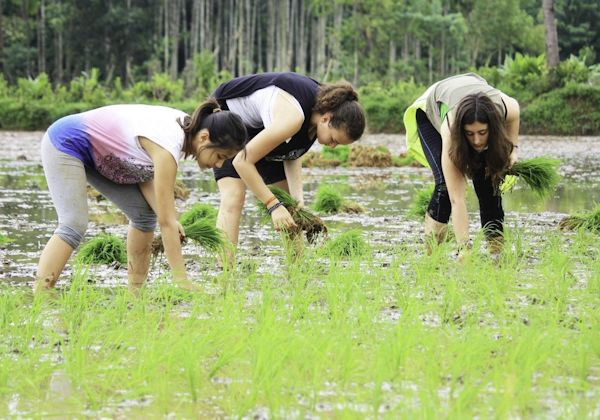
Leisure activities: An 82-foot statue of Anjaneya, commonly known as Hanuman, the monkey god is worth a visit, as is the Kotilingeshwara temple, an ancient Hindu temple dedicated to the god Shiva. Kodi beach, one of the most spectacular in Karnataka is where you can catching amazing sunrises and sunsets. Climb up the winding, spiral staircase to the lantern house to enjoy the panoramic view of the ocean and the town beyond from the lighthouse. Gangoli is situated at the confluence of 5 rivers and the harbour is a busy place where you can interact with the fisherman community. Maravanthe is unique in that the Suparnika river flows on one side of the road, with the beach on the other, the only one of its kind in India.
Kollur Mookambika and Murundeshwara temple where you can view the 2nd largest statue of Shiva, are popular pilgrim spots. Boating on the backwaters of Kundapur, visits to a cashew nut, rubber or tile factory are some interesting ways to spend your free time. You can also visit Indian families to exchange views on your cultures and participate in the cultural programs of the local community. Yakshagana, a form of folk-theatre has been practiced here for the last 400 years. It is a unique blend of musical tradition, eye-catching costumes and authentic styles of dance, improvised gestures and extempore acting which is typical of this region. Do try not to miss this cultural treat.
Language: English
Accommodation: In the local training center, in shared rooms.
Location: Kundapur is a coastal town in Udupi district, Karnataka state in South India. Kundapur is located at the Arabian sea coast, 440 km north west of Bangalore, 91 km north of Mangalore and 35 km from Udupi. The nearest international airports are Bangalore and Mangalore. Kundapur can also be reached from Mumbai, Goa, Bangalore, Mangalore and Kerala by train/bus.
Age range: 18 and over
Extra fee: 6,600 Indian Rupees (about $92 US) for 1 week; 13,200 Indian Rupees (about $184 US) for 2 weeks; 15,400 Indian Rupees (about $215 US) for 3 weeks; 18,700 Indian Rupees (about $260 US) for 4 weeks;
The extra fee is intended to support the local host of the project who does not have sufficient funds. It is due upon arrival.
